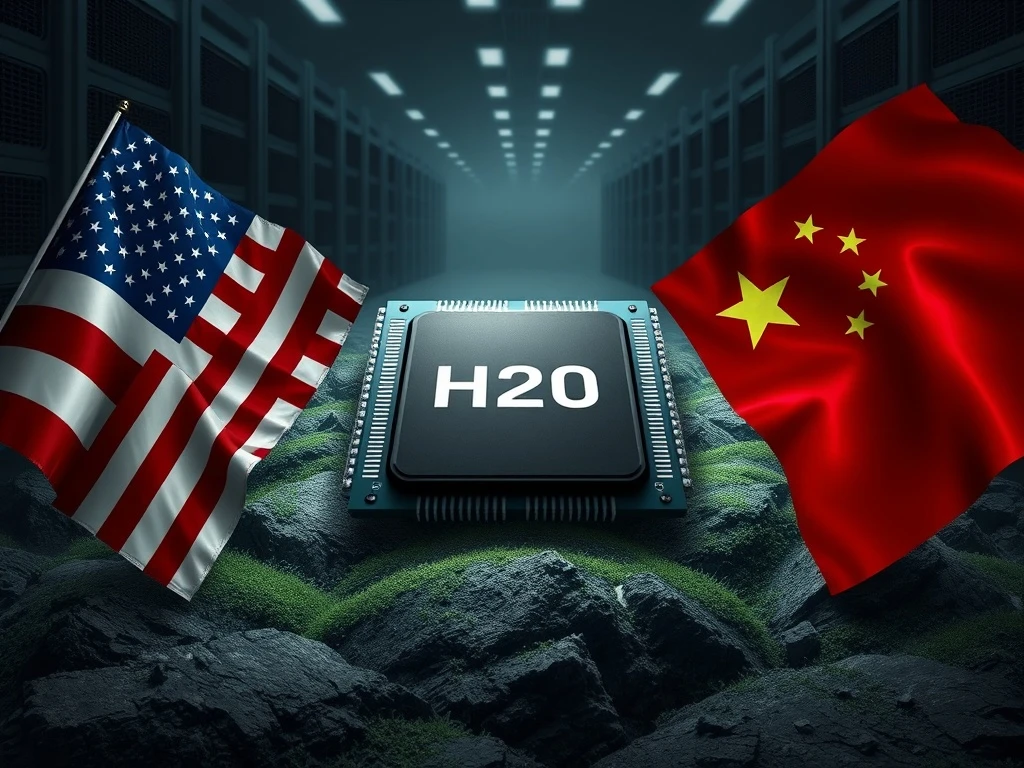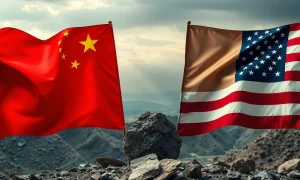The world of technology often intersects with geopolitics. Nowhere is this more evident than with the Nvidia H20 chip. This specialized semiconductor, designed to navigate complex export rules, unexpectedly became a focal point. It now stands at the very heart of the escalating U.S.-China trade war. This conflict reshapes global tech landscapes and impacts future innovation, drawing attention from businesses and entrepreneurs worldwide.
Unpacking the Role of the Nvidia H20 Chip in Geopolitics
The Nvidia H20 chip emerged from a necessity. The United States imposed stringent export controls on advanced artificial intelligence (AI) chips to China. These regulations aimed to curb China’s technological advancements, especially in military applications. Consequently, Nvidia, a leading chip designer, needed a compliant solution for the Chinese market.
The H20 chip represents a tailored version of Nvidia’s powerful data center GPUs. Its design ensures it falls below the performance thresholds set by U.S. Department of Commerce rules. This adaptation allowed Nvidia to continue serving its significant Chinese customer base. However, its very existence highlights the deep divisions shaping the global tech industry.
A Strategic Adaptation for the Chinese Market
Nvidia developed the H20, alongside the L20 and L2, specifically for China. These chips feature reduced processing power compared to their unrestricted counterparts, like the A100 and H100. This modification was crucial for compliance. Therefore, the H20’s introduction marked a significant strategic shift for the company.
Despite its limitations, the Nvidia H20 chip still offers considerable AI computing capabilities. It supports large language models and other complex AI workloads. Its availability provides Chinese tech companies with a viable option. This helps them pursue AI development within regulatory boundaries. However, it also sparks debate about the effectiveness of export controls.
Understanding U.S. Export Controls on Advanced Chips
The U.S. government has progressively tightened restrictions on chip exports to China. These measures began in earnest in late 2022. They target advanced computing chips and semiconductor manufacturing equipment. The primary goal is to prevent China from using cutting-edge technology for military modernization.
- October 2022: Initial broad restrictions on high-performance AI chips were implemented.
- October 2023: Updated rules broadened the scope. They included specific performance density thresholds. These new rules directly impacted chips like Nvidia’s A100 and H100.
- Ongoing Adjustments: The U.S. continues to monitor and adjust these controls. This creates an uncertain environment for companies operating globally.
These controls forced Nvidia to redesign chips for the Chinese market. The Nvidia H20 chip is a direct consequence of these evolving regulations. Its existence shows the intricate balance between national security and global commerce.
The Nvidia H20 Chip: Specifications and Performance
The Nvidia H20 chip is part of the Hopper architecture family. It is optimized for AI inference and training. However, it operates within specific performance limits. These limits are designed to comply with U.S. export regulations.
Let’s compare the H20 to its more powerful siblings:
| Feature | Nvidia H100 | Nvidia A100 | Nvidia H20 |
|---|---|---|---|
| Architecture | Hopper | Ampere | Hopper |
| Memory Bandwidth | ~3.35 TB/s | ~1.55 TB/s | ~400 GB/s |
| Performance (FP16) | ~1,979 TFLOPS (Sparse) | ~624 TFLOPS (Sparse) | Significantly lower (compliance-focused) |
| Key Use Case | High-end AI training, large models | General AI, HPC | AI inference, compliant China market |
| Availability | Global (excluding restricted regions) | Global (excluding restricted regions) | China-specific |
The H20 maintains a large memory capacity. It boasts 96GB of HBM3 memory. This allows it to handle large language models. However, its reduced memory bandwidth and processing power impact overall speed. Thus, it performs slower than the A100 or H100. This trade-off is necessary for regulatory compliance.
China’s Strategic Response and Domestic Chip Ambitions
China views U.S. chip restrictions as a direct challenge to its technological sovereignty. In response, Beijing has intensified its efforts toward self-sufficiency in semiconductors. This includes massive investments in domestic chip manufacturing. Furthermore, it involves nurturing local AI chip designers.
Chinese tech giants like Huawei and Alibaba are developing their own AI accelerators. Huawei’s Ascend series chips, for instance, aim to compete with Nvidia’s offerings. These domestic alternatives are gaining traction. They are increasingly adopted by Chinese companies seeking to reduce reliance on foreign technology.
This push for localization creates new dynamics. It fosters a robust domestic ecosystem. However, it also faces significant hurdles. Access to advanced manufacturing equipment remains a key challenge. Despite this, China’s determination to achieve chip independence remains strong.
The Long Road to Semiconductor Self-Sufficiency
Achieving complete self-sufficiency in advanced semiconductors is a monumental task. It requires decades of investment and expertise. China has made considerable progress. However, it still lags behind global leaders in certain critical areas. These include lithography equipment and advanced chip design software.
The U.S. export controls accelerate China’s domestic innovation. They also highlight its vulnerabilities. Chinese companies are exploring various strategies. These include parallel development paths and international partnerships. This complex environment shapes the future of the global semiconductor industry.
Broader Geopolitical Implications of the Chip War
The saga of the Nvidia H20 chip extends beyond corporate strategy. It underscores a broader geopolitical struggle. This conflict impacts global supply chains and technological leadership. Nations are increasingly viewing advanced chips as strategic assets.
- Supply Chain Resilience: The trade war encourages diversification of supply chains. Countries aim to reduce dependence on single regions or suppliers. This enhances resilience but may increase costs.
- Technological Decoupling: The U.S. and China are gradually decoupling their tech ecosystems. This creates distinct standards and innovations. It could lead to a fragmented global tech landscape.
- Global AI Race: Restrictions on AI chips impact the pace of AI development. Countries like China might develop different AI capabilities. This could lead to a bifurcation of AI research and applications.
The competition for chip dominance is a defining feature of the 21st century. Its outcomes will shape economic power and national security.
Economic Repercussions for Nvidia and Global Markets
Nvidia, a major player in the semiconductor industry, faces significant economic repercussions. China represents a substantial market for the company. The export restrictions directly impact its revenue streams.
Initially, Nvidia’s stock faced volatility following the restrictions. However, the company’s overall strong performance in other markets has mitigated some losses. Demand for its unrestricted chips in regions like the U.S. and Europe remains robust. Furthermore, the development of compliant chips like the H20 demonstrates adaptability.
The broader semiconductor market also feels the effects. Companies involved in chip manufacturing, design, and equipment face uncertainty. Investors closely watch policy developments. They assess the potential for further restrictions or escalations. This climate of uncertainty influences investment decisions across the tech sector.
Navigating Market Volatility and Strategic Shifts
Market participants must understand the evolving regulatory landscape. Companies like Nvidia are diversifying their product offerings. They are also exploring new markets. This proactive approach helps mitigate risks associated with geopolitical tensions.
The long-term impact on global tech innovation remains to be seen. Some argue that restrictions stifle innovation. Others believe they spur domestic development. Ultimately, the Nvidia H20 chip serves as a stark reminder of these complex forces at play.
Navigating the Complex Landscape: Future Outlook
The future of the U.S.-China chip war remains uncertain. Both nations continue to pursue their strategic objectives. Companies like Nvidia must navigate this complex and dynamic environment.
They must prioritize compliance with evolving regulations. They also need to maintain innovation. Furthermore, they should explore opportunities in compliant markets. The global semiconductor industry will likely see continued fragmentation. It will also witness increased regionalization of supply chains.
The Nvidia H20 chip exemplifies a company’s attempt to adapt. It showcases resilience in the face of geopolitical challenges. Its story highlights the ongoing tension between technological advancement and national security interests.
The Nvidia H20 chip is more than just a piece of hardware. It embodies the intense technological rivalry between the U.S. and China. Its development and deployment illustrate the direct impact of trade policies on global industries. This chip serves as a powerful symbol. It represents the delicate balance companies must strike. They must weigh commercial interests against national security concerns. As the U.S.-China trade war continues, the role of such specialized technologies will remain central. They will shape the future of AI and global technological leadership.
Frequently Asked Questions (FAQs)
Q1: What is the Nvidia H20 chip?
A1: The Nvidia H20 chip is a specialized artificial intelligence (AI) graphics processing unit (GPU). Nvidia designed it specifically for the Chinese market. It complies with U.S. export control regulations on advanced AI chips.
Q2: Why was the Nvidia H20 chip developed?
A2: Nvidia developed the H20 chip to circumvent U.S. export restrictions. These restrictions prevent the sale of its most powerful AI chips (like the A100 and H100) to China. The H20 offers reduced performance, ensuring it falls below the regulated thresholds.
Q3: How does the H20 chip compare to Nvidia’s other high-end chips like the H100?
A3: The Nvidia H20 chip has significantly lower processing power and memory bandwidth compared to the H100 or A100. While it retains a large memory capacity (96GB HBM3), its overall performance is reduced. This makes it compliant with U.S. export rules for the Chinese market.
Q4: What is the U.S.-China trade war’s impact on the semiconductor industry?
A4: The U.S.-China trade war, particularly regarding semiconductors, has led to increased geopolitical tensions. It has spurred China’s drive for chip self-sufficiency. It also forced global companies like Nvidia to adapt their product strategies. This impacts supply chains and the pace of global AI development.
Q5: Will the Nvidia H20 chip help China achieve AI superiority?
A5: The Nvidia H20 chip provides Chinese companies with access to advanced AI hardware within legal limits. While it supports AI development, its reduced performance means China still seeks more powerful domestic alternatives or advanced chips. It helps maintain some level of AI progress but does not guarantee superiority.
Q6: What does the H20 chip saga mean for global tech companies?
A6: The H20 chip saga highlights the growing challenges for global tech companies. They must navigate complex geopolitical landscapes and evolving trade policies. It emphasizes the need for strategic adaptation, supply chain diversification, and continuous innovation. All this happens while balancing commercial interests with national security concerns.






